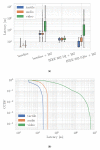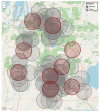Healing Hands: The Tactile Internet in Future Tele-Healthcare
- PMID: 35214306
- PMCID: PMC8963047
- DOI: 10.3390/s22041404
Healing Hands: The Tactile Internet in Future Tele-Healthcare
Abstract
In the early 2020s, the coronavirus pandemic brought the notion of remotely connected care to the general population across the globe. Oftentimes, the timely provisioning of access to and the implementation of affordable care are drivers behind tele-healthcare initiatives. Tele-healthcare has already garnered significant momentum in research and implementations in the years preceding the worldwide challenge of 2020, supported by the emerging capabilities of communication networks. The Tactile Internet (TI) with human-in-the-loop is one of those developments, leading to the democratization of skills and expertise that will significantly impact the long-term developments of the provisioning of care. However, significant challenges remain that require today's communication networks to adapt to support the ultra-low latency required. The resulting latency challenge necessitates trans-disciplinary research efforts combining psychophysiological as well as technological solutions to achieve one millisecond and below round-trip times. The objective of this paper is to provide an overview of the benefits enabled by solving this network latency reduction challenge by employing state-of-the-art Time-Sensitive Networking (TSN) devices in a testbed, realizing the service differentiation required for the multi-modal human-machine interface. With completely new types of services and use cases resulting from the TI, we describe the potential impacts on remote surgery and remote rehabilitation as examples, with a focus on the future of tele-healthcare in rural settings.
Keywords: human-in-the-loop; multi-modal; multisensory perception; tactile internet; tele-healthcare.
Conflict of interest statement
The authors declare no conflict of interest.
Figures




Similar articles
-
IoTactileSim: A Virtual Testbed for Tactile Industrial Internet of Things Services.Sensors (Basel). 2021 Dec 15;21(24):8363. doi: 10.3390/s21248363. Sensors (Basel). 2021. PMID: 34960454 Free PMC article.
-
Essential Case Management Practices Amidst the Novel Coronavirus Disease 2019 (COVID-19) Crisis: Part 1: Tele-Case Management, Surge Capacity, Discharge Planning, and Transitions of Care.Prof Case Manag. 2020 Sep/Oct;25(5):248-266. doi: 10.1097/NCM.0000000000000454. Prof Case Manag. 2020. PMID: 32452941 Free PMC article.
-
Tele-practice for children and young people with communication disabilities: Employing the COM-B model to review the intervention literature and inform guidance for practitioners.Int J Lang Commun Disord. 2021 Mar;56(2):415-434. doi: 10.1111/1460-6984.12592. Epub 2021 Feb 1. Int J Lang Commun Disord. 2021. PMID: 33522068 Review.
-
Tele-dermatology in Australia.Stud Health Technol Inform. 2008;131:245-53. Stud Health Technol Inform. 2008. PMID: 18305334
-
Tele-Audiology: Current State and Future Directions.Front Digit Health. 2022 Jan 10;3:788103. doi: 10.3389/fdgth.2021.788103. eCollection 2021. Front Digit Health. 2022. PMID: 35083440 Free PMC article. Review.
Cited by
-
Special Issue: "Intelligent Systems for Clinical Care and Remote Patient Monitoring".Sensors (Basel). 2023 Sep 20;23(18):7993. doi: 10.3390/s23187993. Sensors (Basel). 2023. PMID: 37766047 Free PMC article.
References
-
- Sanders C., Rogers A., Bowen R., Bower P., Hirani S., Cartwright M., Fitzpatrick R., Knapp M., Barlow J., Hendy J., et al. Exploring barriers to participation and adoption of telehealth and telecare within the Whole System Demonstrator trial: A qualitative study. BMC Health Serv. Res. 2012;12:220. doi: 10.1186/1472-6963-12-220. - DOI - PMC - PubMed
MeSH terms
Grants and funding
LinkOut - more resources
Full Text Sources
Medical

